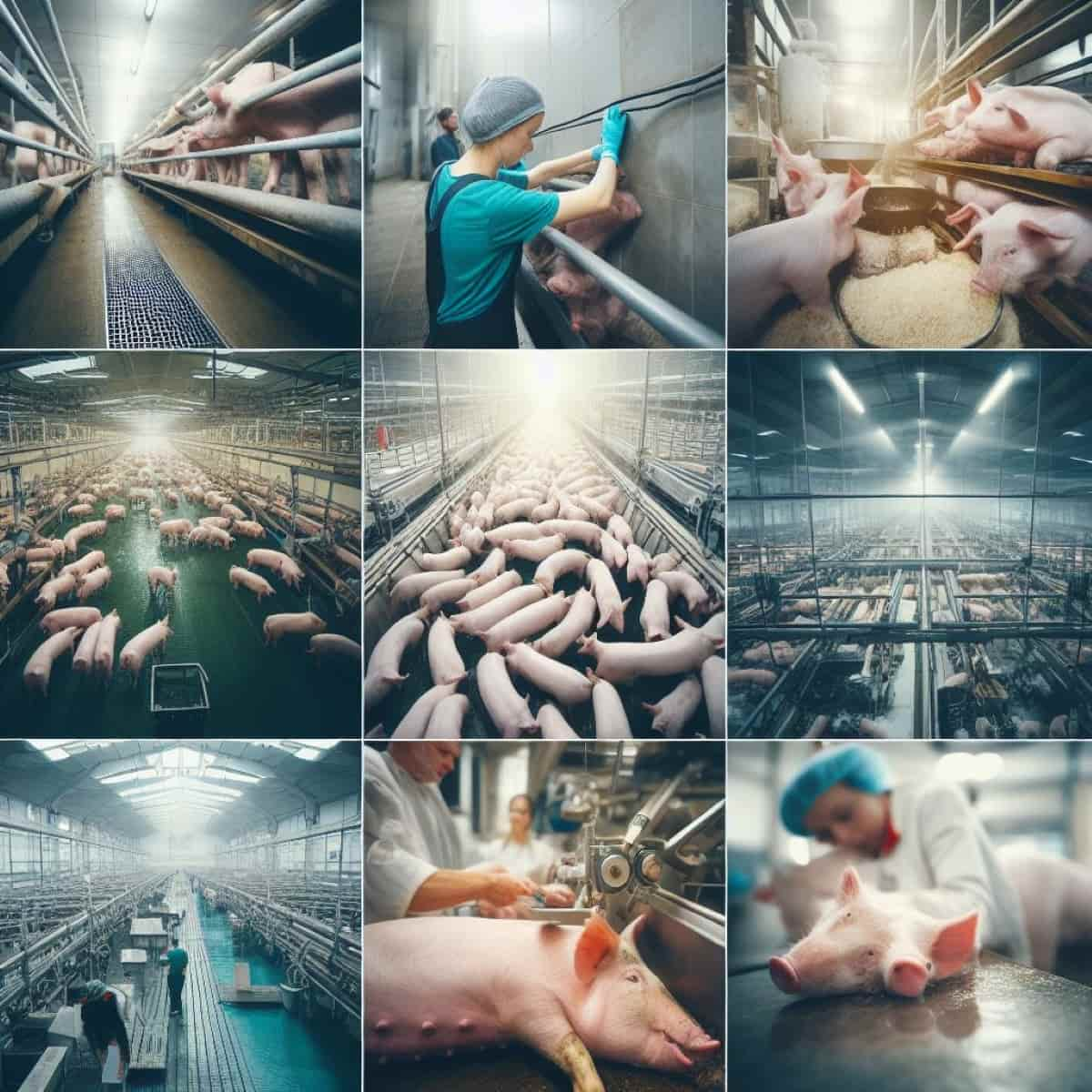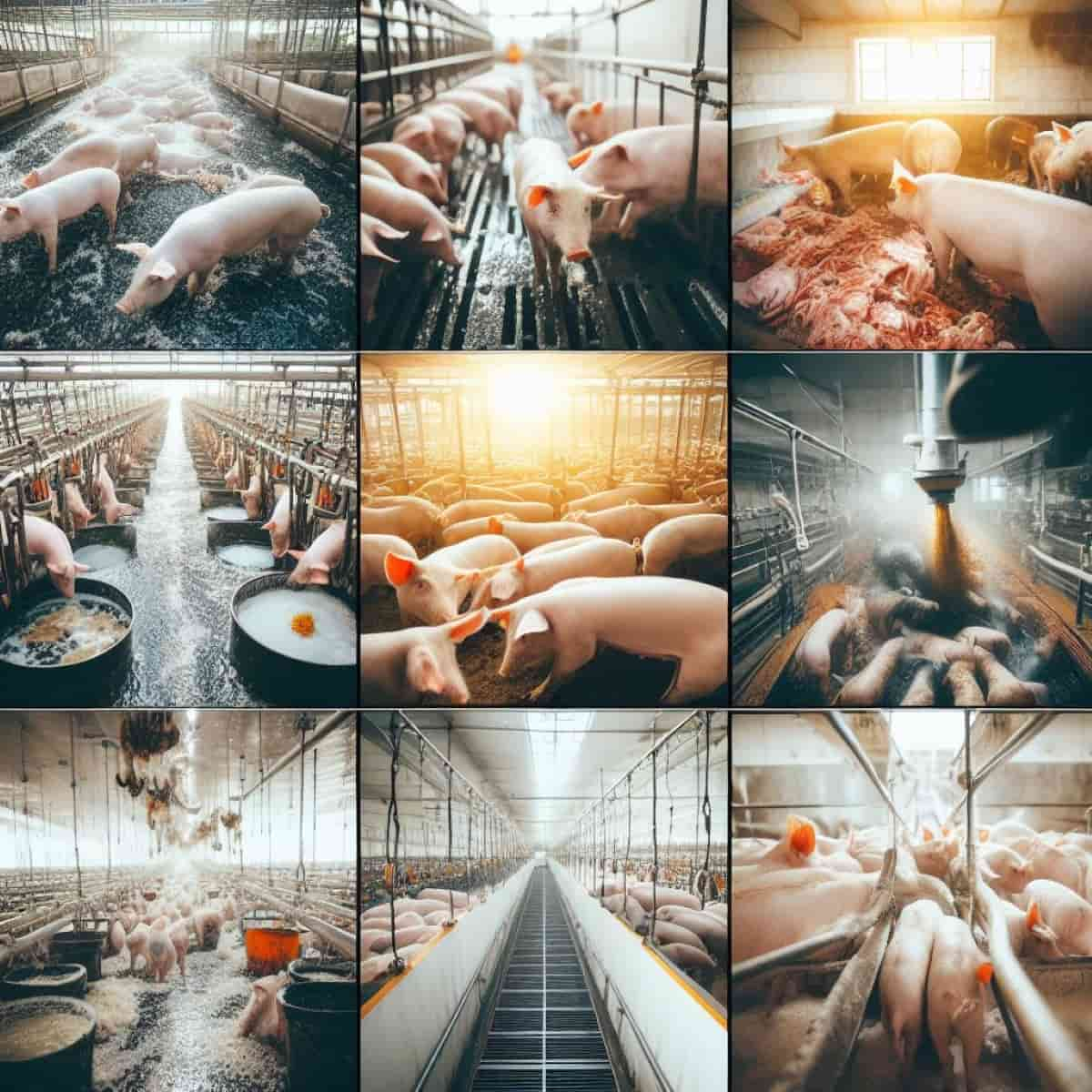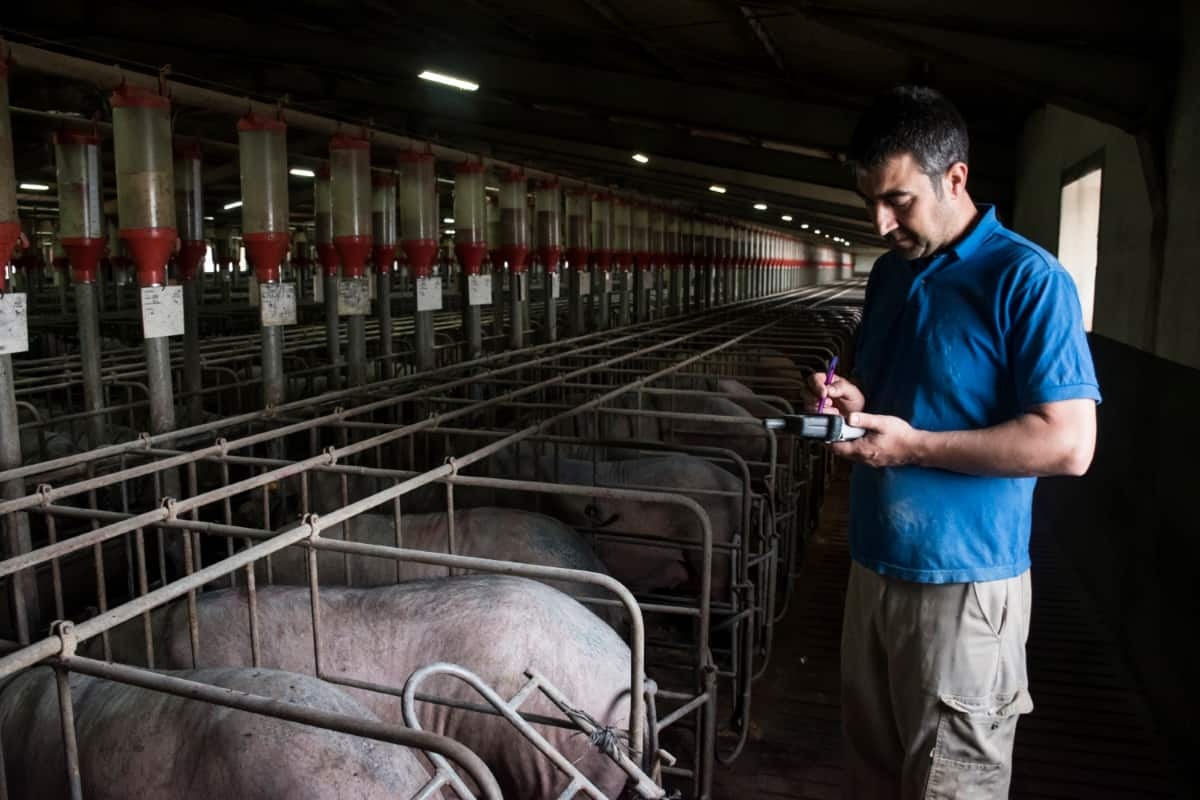Technological advancements allow pig farmers to use automation to modernize their operations and increase efficiency. In modern pig production, automation uses machinery, robotics, and sensors to perform various tasks once done manually. This includes feeding pigs, monitoring their health, managing temperature and ventilation systems, and sorting and transporting them. The introduction of automation has brought about numerous benefits for pig farmers.

Technology in Modern Pig Production
Benefits of Automation in Pig Farming
Automation in pig farming has revolutionized how pigs are raised and managed, bringing numerous benefits to farmers and animals. The key advantage of automation in pig farming is increased efficiency. Automated systems can streamline and optimize feeding, watering, and waste management. This not only saves time for farmers but also ensures that pigs receive their required nutrients consistently.
Another benefit is improved animal welfare. Automated systems enable precise control over pig barns’ environmental factors like temperature, humidity, and ventilation. Automation also plays a crucial role in disease prevention and biosecurity. Minimizing human contact with the pigs significantly reduces the risk of introducing diseases or pathogens into the farm. Additionally, automated health monitoring systems can detect early signs of illness or distress in individual pigs, allowing prompt intervention and treatment.
Role of Robotics in Modern Pig Production
With the help of robots, farmers can automate various tasks and streamline their operations to improve efficiency and productivity. Robotics play a crucial role in feeding systems. Automated feeders can distribute precise amounts of feed at regular intervals, ensuring that pigs receive optimal nutrition without any wastage. This reduces labor requirements and promotes healthier growth and weight management among pigs.
Robots are also being used for cleaning and waste management on pig farms. They can autonomously clean barns, removing manure and other waste materials efficiently. This improves hygiene conditions for the animals and reduces the risk of disease transmission. In addition to feeding and cleaning, robots are employed for monitoring animal health in modern pig production. Furthermore, robotic technologies enable data collection on various aspects such as feed intake, growth rates, environmental conditions, etc.
IoT Applications in Pig Farming
The Internet of Things (IoT) has revolutionized different industries, and pig farming is no exception. IoT applications in pig farming have significantly improved the monitoring and managing of pigs’ health, behavior, and overall well-being. The application of IoT in pig farming is the use of sensors. These small devices can be attached to pigs or placed within their environment to collect data on temperature, humidity, air quality, and even individual pig activity levels.
In case you missed it: Pig Breeding Calendar: Pig Gestation Stages and Pig Gestation Table

Farmers can gain valuable insights into the pigs’ living conditions with the data collected by the sensors. For example, if a sensor detects an increase in temperature beyond a certain threshold, it could indicate potential heat stress among the pigs. This early warning system allows farmers to take quick action to prevent any adverse effects on the animals’ health.
Precision Livestock Farming: A Game Changer in Pig Production
This emerging technology utilizes various sensors and monitoring devices to collect data on individual pigs, enabling farmers to make decisions and optimize their operations. By equipping pigs with wearable devices that track vital signs such as temperature, heart rate, and activity levels, farmers can quickly identify any potential health issues or distress signals. This proactive approach allows for early intervention and targeted treatment, ultimately improving animal welfare.
Another component of precision livestock farming is the use of automated feeding systems. These systems accurately measure and dispense feed based on each pig’s nutritional needs. Additionally, with the help of advanced analytics algorithms, data collected from various sources can be analyzed to detect patterns that may indicate disease outbreaks or suboptimal conditions within the pig herd.
Data Analytics and Artificial Intelligence in Pig Farming
With the help of data analytics, pig farmers can gain insights into different production features. By utilizing algorithms and machine learning techniques, AI-powered systems can analyze data collected from sensors, cameras, and other monitoring devices installed on the farm. Through data analytics and AI, pig farmers can optimize feed efficiency by identifying trends in consumption patterns. They can also detect early signs of health issues by analyzing changes in behavior or vital signs captured through sensors. This allows for prompt intervention and improves animal welfare.
Advancements in Genetic Engineering for Improved Pig Production
Farmers can breed pigs more resistant to common diseases such as swine flu or porcine reproductive and respiratory syndrome (PRRS) by introducing specific genes into the pig’s DNA. This reduces the risk of disease outbreaks and minimizes the need for antibiotics, promoting healthier livestock and safer meat products.
Furthermore, genetic engineering enables producers to enhance meat quality attributes such as tenderness, marbling, and flavor. By selecting specific genes associated with these traits and incorporating them into breeding programs, farmers can consistently produce high-quality pork products that meet consumer preferences. It is important that genetic engineering holds great potential for enhancing pig production; it also raises ethical considerations and concerns about long-term effects on biodiversity.
Smart Barns: Revolutionizing Pig Housing Systems
These innovative housing systems have revolutionized how pigs are raised, offering numerous benefits for farmers and animals alike. The main feature of smart barns is their ability to monitor and control environmental conditions with precision. Temperature, humidity, ventilation, and lighting can all be regulated automatically to create optimal living conditions for the pigs.
In case you missed it: Project Report on Pig Farming: Cost and Profit Analysis

This ensures their comfort and improves their overall health and well-being. Furthermore, smart barns offer enhanced biosecurity measures through controlled access points for humans entering or exiting the facility. This helps prevent disease outbreaks by minimizing exposure risks from external sources such as visitors or vehicles.
Automated Feeding Systems for Enhanced Efficiency and Health Monitoring
The system can be programmed to dispense specific amounts of feed at precise intervals, ensuring that each pig receives its required portion. This eliminates overfeeding or underfeeding, resulting in healthier and more productive pigs. In addition to efficiency, these systems also play a crucial role in health monitoring. Any abnormalities or changes can be quickly detected by tracking each pig’s eating patterns and behavior through sensors and data analysis.
Moreover, automated feeding systems in pig farms enable real-time data collection on feed consumption for individual pigs or groups. This helps farmers make informed decisions regarding nutritional adjustments based on specific requirements or growth stages of their animals. Automated feeding systems offer significant efficiency and health management advantages in modern pig farming.
Technology-Driven Health Management in Pig Farms
With advanced tools and systems, farmers can now closely monitor the health of their pigs and take proactive measures to prevent diseases and ensure optimal well-being. The main aspect of technology-driven health management in pig farms is using sensors and monitoring devices. In real-time, these devices can track vital signs such as body temperature, heart rate, and respiratory rate. Farmers can promptly detect any abnormalities or early signs of illness by collecting this data.
Furthermore, these sensors can be integrated with software systems that utilize data analytics and artificial intelligence algorithms. This enables farmers to analyze large amounts of information quickly and accurately and identify patterns or potential health issues within their pig herds. With this valuable insight at their fingertips, they can make informed decisions regarding treatment protocols or adjustments in feed formulations. Another technological advancement that contributes to efficient health management is the development of wearable devices for pigs.
Frequently Asked Questions on Modern Pig Production
How Does Technology Improve Animal Welfare?
Technology plays a crucial role in enhancing animal welfare in pig production. For instance, smart monitoring systems can track individual pigs’ behavior and health indicators such as feed intake or weight gain. This enables early detection of potential issues or diseases, leading to prompt intervention and better overall animal care.
What Types of Automated Systems are Used in Pig Farming?
There are various automated systems utilized in modern pig production. These include robotic feeders that dispense precise amounts of feed, automatic sorting gates based on weight or RFID tags, and even autonomous drones for monitoring herd health.
In case you missed it: 15 Cheapest Ways to Build a Pig Pen: Budget-Friendly Construction Ideas, Tips, and Techniques

Conclusion
Farmers utilize various tools and technologies to create an optimal animal environment in modern pig production. Modern pig production refers to the use of advanced technologies and innovative techniques in the farming of pigs. It goes beyond traditional methods and embraces automation, data analysis, and precision livestock farming.
- Feed Your Flock for Less: Top 10 Tips to Save on Chicken Feed
- Ultimate Guide to Ossabaw Island Hog: Breeding, Raising, Diet, and Care
- Hatching Answers: The Top 10 Reasons Your Chickens Aren’t Laying Eggs
- Eggs and Economics: Breaking Down the Cost of Raising Backyard Chickens
- Defend Your Greens: Proven Methods to Keep Iguanas Out of Your Garden
- Ultimate Guide to Cinnamon Queen Chicken: A Comprehensive Guide for Beginners
- Ultimate Guide to California Tan Chicken: Breeding, Raising, Diet, Egg-Production and Care
- Ultimate Guide to Marsh Daisy Chicken: Breeding, Raising, Diet, and Care
- 10 Types of Chicken Farming Businesses You Can Start for Profits